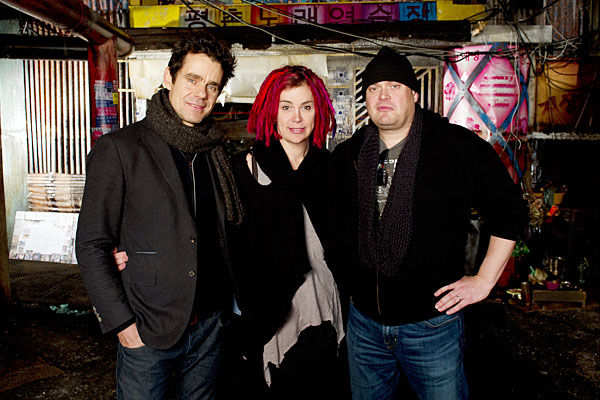
Director Tom Tykwer with Lana and Andy Wachowski
There’s something in science called the Stroop Effect, and I experienced it when I sat through the second-ever public screening of the epic film Cloud Atlas in New York in early October. Discovered in 1936, the Stroop Effect describes what happens in your brain when you are presented with conflicting information. For example, if someone asks you to read the name of a color from a card, and the word is grey and it is written in grey ink, you will probably quickly say the right answer. But when the next word is orange, but it is written in green ink, your brain stumbles a bit before it can kick into gear.
On to Cloud Atlas, an ambitious and challenging movie that opens here on Wednesday as part of the Chicago International Film Festival (for info, chicagofilmfestival.com) and will almost certainly become part of film studies curriculum everywhere once the academics pin it down. Based on the novel by the Irishman Ireland-based writer David Mitchell, it was turned into a screenplay and then directed by a daunting trio: the Chicago siblings Lana Wachowski and Andy Wachowski (of the Matrix fame) and the German director Tom Tykwer (Run Lola Run).
Transcending most moviemaking conventions, the film weaves in and out of six stories, which take place from roughly the 1700s, to the post-apocalyptic present, to the year 2144. A handful of actors, including Tom Hanks, Halle Berry, Jim Broadbent, and Hugh Grant looking as wretched as you’ve ever seen him, juggle multiple roles throughout, which sometimes works brilliantly (Hugh Grant in savage head-to-toe warpaint), and sometimes fails miserably (the South Korean actress Bae Doona in a ginger-colored wig and green contacts).
There have been detailed stories about the mechanics of how the movie was made, most notably in the New Yorker and The New York Times. But nothing really helped rescue me from feeling “Stroop-ed” as did hearing the filmmakers explain why: why they sunk their own money and four years of their creative energy into the project, and why they made some of the unconventional artistic choices that they did.
Speaking as part of a New Yorker Festival panel after the screening I attended in New York, Lana Wachowski (born Laurence Wachowski in 1965 in Beverly and a graduate of Whitney Young) said right off the bat that she had grown to loathe the way “that cinema is so regimented,” so she was casting about for a project that had “scale and breadth and philosophical underpinnings.” (Check.) After reading Mitchell’s book (which the actress Natalie Portman recommended to her on the set of V for Vendetta, which the Wachowskis directed), she knew almost immediately that she had found one. She says she imagined “something epic, like Lawrence of Arabia,” and something that “would make a difference” in the movie industry, perhaps advancing the genre if it possibly could.
She explained, too, that she was eager to blur the boundaries between comedy and dramas and thrillers (check). “It was our goal to dissolve genres, and instead slowly weave them together,” she added. And the tone does zigzag—funny here, tragic there, just plain creepy in most of the scenes that take place in 2144 in a place called Neo-Seoul—but doesn’t feel fragmented, mostly because the direction trio decided early on that they needed some consistent threads (casting, music) that would be a constant and weave throughout the stories.
So they came up with the idea of an ensemble cast, or revolving door of actors, an ambitious idea that didn’t always work for me when I watched it. “We wanted to have one ensemble to stitch the movie together, to help us understand the things people do,” explained Andy Wachowski (born in 1967 in Beverly). And indeed, the idea that we are bound to others in the past and present, even if our lives seem like a flicker on nature’s great timeline, is a theme throughout. But sometimes it’s just plain Stroop-y to see Halle Berry pop up in one scene as a foxy newspaper reporter, and then appear in the next as a 1930s muse in period costume and pale face powder. Or see Tom Hanks suddenly start speaking a made-up Pidgin language, when just a minute ago he was in another scene stringing together subjects and verbs just fine.
The most successful uniting element, or at least in my mind, was the musical score, which Tykwer composed, then refashioned for each era in the story. He wrote the music before they began shooting the film—and Lana Wachowski says it was such a powerful reversal of process that she’ll never go back. “Usually we get to the end of a film and we put someone else’s music on it,” she said. “But I won’t go back to the flat Earth way”—proof that Stroop-ing the creative process can pay off artistically, even if the final product isn't without fault.
Photograph: Jay Maidment/Warner Bros.


